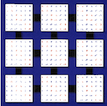1 SUBROUTINE pzgetrrv( M, N, A, IA, JA, DESCA, IPIV, WORK )
12 INTEGER DESCA( * ), IPIV( * )
13 COMPLEX*16 A( * ), WORK( * )
144 INTEGER BLOCK_CYCLIC_2D, CSRC_, CTXT_, DLEN_, DTYPE_,
145 $ LLD_, MB_, M_, NB_, N_, RSRC_
146 parameter( block_cyclic_2d = 1, dlen_ = 9, dtype_ = 1,
147 $ ctxt_ = 2, m_ = 3, n_ = 4, mb_ = 5, nb_ = 6,
148 $ rsrc_ = 7, csrc_ = 8, lld_ = 9 )
150 parameter( one = 1.0d+0, zero = 0.0d+0 )
153 CHARACTER COLBTOP, ROWBTOP
154 INTEGER IACOL, IAROW, ICTXT, IL, IPL, IPU, IROFF, J,
155 $ JB, JL, JN, MN, MP, MYCOL, MYROW, NPCOL, NPROW
157 INTEGER DESCIP( DLEN_ ), DESCL( DLEN_ ),
158 $ DESCU( DLEN_ ), IDUM( 1 )
161 EXTERNAL blacs_gridinfo,
descset, pb_topget, pb_topset,
165 INTEGER ICEIL, INDXG2P, NUMROC
166 EXTERNAL iceil, indxg2p, numroc
175 ictxt = desca( ctxt_ )
176 CALL blacs_gridinfo( ictxt, nprow, npcol, myrow, mycol )
178 iroff = mod( ia-1, desca( mb_ ) )
179 iarow = indxg2p( ia, desca( mb_ ), myrow, desca( rsrc_ ), nprow )
180 mp = numroc( m+iroff, desca( mb_ ), myrow, iarow, nprow )
182 ipu = ipl + mp * desca( nb_ )
183 CALL pb_topget( ictxt,
'Broadcast',
'Rowwise', rowbtop )
184 CALL pb_topget( ictxt,
'Broadcast',
'Columnwise', colbtop )
185 CALL pb_topset( ictxt,
'Broadcast',
'Rowwise',
'S-ring' )
186 CALL pb_topset( ictxt,
'Broadcast',
'Columnwise',
' ' )
191 il =
max( ( ( ia+mn-2 ) / desca( mb_ ) ) * desca( mb_ ) + 1, ia )
192 jl =
max( ( ( ja+mn-2 ) / desca( nb_ ) ) * desca( nb_ ) + 1, ja )
193 jn =
min( iceil( ja, desca( nb_ ) )*desca( nb_ ), ja+mn-1 )
194 iarow = indxg2p( il, desca( mb_ ), myrow, desca( rsrc_ ), nprow )
195 iacol = indxg2p( jl, desca( nb_ ), mycol, desca( csrc_ ), npcol )
197 CALL descset( descl, ia+m-il, desca( nb_ ), desca( mb_ ),
198 $ desca( nb_ ), iarow, iacol, ictxt,
max( 1, mp ) )
200 CALL descset( descu, desca( mb_ ), ja+n-jl, desca( mb_ ),
201 $ desca( nb_ ), iarow, iacol, ictxt, desca( mb_ ) )
203 CALL descset( descip, desca( m_ ) + desca( mb_ )*nprow, 1,
204 $ desca( mb_ ), 1, desca( rsrc_ ), mycol, ictxt,
205 $ numroc( desca( m_ ), desca( mb_ ), myrow,
206 $ desca( rsrc_ ), nprow ) + desca( mb_ ) )
209 DO 10 j = jl, jn+1, -desca( nb_ )
211 jb =
min( ja+mn-j, desca( nb_ ) )
215 CALL pzlacpy(
'Lower', m-il+ia, jb, a, il, j, desca,
216 $ work( ipl ), 1, 1, descl )
217 CALL pzlaset(
'Upper', m-il+ia, jb, zero, one, work( ipl ),
222 CALL pzlacpy(
'Upper', jb, ja+n-j, a, il, j, desca,
223 $ work( ipu ), 1, 1, descu )
224 CALL pzlaset(
'Lower', jb-1, ja+n-j, zero, zero,
225 $ work( ipu ), 2, 1, descu )
229 CALL pzlaset(
'Lower', ia+m-il-1, jb, zero, zero, a, il+1, j,
234 CALL pzlaset(
'Upper', jb, ja+n-j, zero, zero, a, il, j,
239 CALL pzgemm(
'No transpose',
'No transpose', ia+m-il,
240 $ ja+n-j, jb, one, work( ipl ), 1, 1, descl,
241 $ work( ipu ), 1, 1, descu, one, a, il, j, desca )
243 il = il - desca( mb_ )
244 descl( m_ ) = descl( m_ ) + descl( mb_ )
245 descl( rsrc_ ) = mod( descl( rsrc_ ) + nprow - 1, nprow )
246 descl( csrc_ ) = mod( descl( csrc_ ) + npcol - 1, npcol )
247 descu( n_ ) = descu( n_ ) + descu( nb_ )
248 descu( rsrc_ ) = descl( rsrc_ )
249 descu( csrc_ ) = descl( csrc_ )
255 jb =
min( jn-ja+1, desca( nb_ ) )
259 CALL pzlacpy(
'Lower', m, jb, a, ia, ja, desca, work( ipl ),
261 CALL pzlaset(
'Upper', m, jb, zero, one, work( ipl ), 1, 1,
266 CALL pzlacpy(
'Upper', jb, n, a, ia, ja, desca, work( ipu ), 1,
268 CALL pzlaset(
'Lower', jb-1, n, zero, zero, work( ipu ), 2, 1,
273 CALL pzlaset(
'Lower', m-1, jb, zero, zero, a, ia+1, ja, desca )
277 CALL pzlaset(
'Upper', jb, n, zero, zero, a, ia, ja, desca )
281 CALL pzgemm(
'No transpose',
'No transpose', m, n, jb, one,
282 $ work( ipl ), 1, 1, descl, work( ipu ), 1, 1,
283 $ descu, one, a, ia, ja, desca )
287 CALL pzlapiv(
'Backward',
'Row',
'Col',
min( m, n ), n, a, ia, ja,
288 $ desca, ipiv, ia, 1, descip, idum )
290 CALL pb_topset( ictxt,
'Broadcast',
'Rowwise', rowbtop )
291 CALL pb_topset( ictxt,
'Broadcast',
'Columnwise', colbtop )

